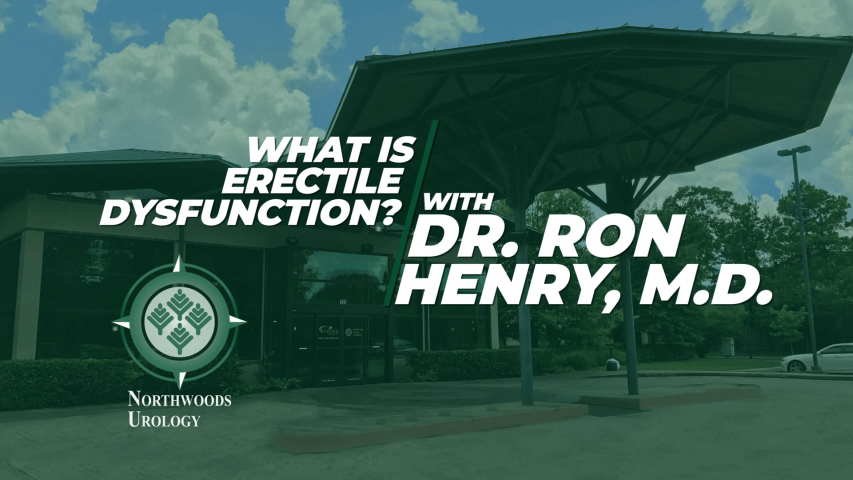Transcript of Video
I’m Dr. Ron Henry, with Northwoods Urology of Texas. And today we’re gonna talk about erectile dysfunction, or ED as it’s commonly known these days.
Erectile dysfunction is the inability to obtain or maintain an erection or maintain an adequate erection that is good for sexual activity. Erectile dysfunction can really occur at almost any age. The more typical patient is one that is a bit older as they’re aging. And also there are many medical diseases that would contribute to erectile dysfunction. These would include blood pressure problems, or cardiovascular disease, diabetes in particular, and high cholesterol. The reason that those patients are more susceptible to erectile dysfunction, is because that has an impact on blood flow. And actually getting and maintaining an erection, requires the increase in blood flow to the penis. There are really almost two sponges in the penis that fill with blood. They’re called the corpus cavernosum. And anything that has an impact on blood flow, can cause some problems with ED.
There are actually multiple treatments available for ED. Certainly, most everyone these days is heard about Viagra, Cialis and the various medications. Those drugs actually open the blood vessels, they’re typically meant to be taken at the time of sexual activity or planned sexual activity, so there is some planning involved. But those drugs open the blood vessels, but don’t cause an erection in itself, It really requires stimulation, in order to increase the blood flow, and if the vessels are open, it’s hopefully gonna give you better quality erections or longer lasting erections. Besides oral medicine, there are many other options as well.
Back in the day before any of those drugs were available, some people used vacuum device, this was a sleeve or a cylinder, and by creating a vacuum, it actually sucked blood into the penis so to speak, and then would use a ring or flange at the base of the penis to keep the blood there so it didn’t flow right out. Nowadays, we have even some newer options. In addition to the oral medication, there’s actually injections that can be performed. It’s a basically a small syringe, almost like a diabetic syringe, with a very tiny gauge needle, and that’s actually injected into the corpus. This is typically medications that are made up by compounding pharmacies, they’re what we call vaisal dilators. And the difference is, is that, with an injection, not only does it open the vessels, but it increases the flow. So within about 10 or 15 minutes typically, those patients hopefully would have an adequate erection.
We don’t just prescribe those injectable medications casually, normally will make a patient come in, do a test injection in the office, to see if they respond and would be a good candidate for prescription. In the past two to three years, we’ve actually been using some penile shockwave therapy. What this does is that those vessels that we talked about in the penis that have become a little bit stiff, they’re perhaps a little fibrotic, and so they don’t expand as well. And so the purpose of the penile Shockwave, is to make those vessels more elastic so that one could then respond better to stimulation, or allow oral medications to work better for these patients. Typically the shockwave treatment requires probably five or six treatments over either one or twice, once or twice a week. And we’ve had very good success, probably 75% of patients notice improvement in the quality of their erections, although there’s no way to really predict ahead of time, how well that’s going to work.
If you feel like you’re having some issues with ED or erectile dysfunction, please contact our office for an appropriate evaluation and counseling regarding various treatment options that would be successful.




